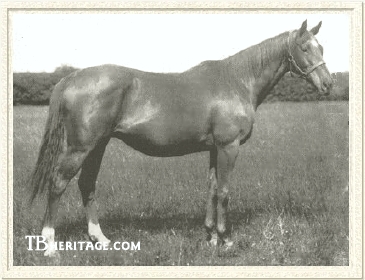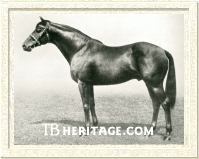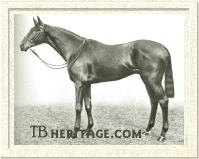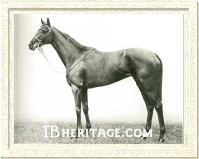|
|
Scapa Flow

|
|
 |
|
|
Although just a moderate racemare, Lord Derby's Scapa Flow proved herself one of the most influential broodmares in the Stud Book. Dam of two classic winners, Fairway and Fair Isle, she is more important as the dam of the two full brothers, Pharos and Fairway, both Leading Sires in England and whose male lines have proliferated around the world.
Scapa Flow was a homebred for the 17th Earl of Derby, who had purchased her dam, Anchora (1905 by Love Wisely ‚ Eryholme by Hazelhatch) on the advice of trainer George Lambton, who felt her race record and pedigree added a much needed dimension of stoutness to the Derby bloodstock. Anchora had been bred by George Edwardes of the Ballykisteen Stud and was a later maturing type. Unplaced at two, she won once at three, three times at four, and although not a winner at five, placed in four stakes. At six, she ran 15 times and won three times including the Brighton Stakes, and third in the Chester Cup. At seven, in 1912, Anchora was offered at the Second Spring Sales at Newmarket and purchased by Lord Derby for 1,966 pounds. She had accumulated a record of eight wins in 51 starts, proving sound and resilient, although primarily a stayer like her sire, Ascot Gold Cup winner Love Wisely.
Retired to Lord Derby's stud at Newmarket, Anchora produced five winners, the best of which was her first foal, Scapa Flow, a chestnut filly by Chaucer foaled in 1914. Anchora's only other foal of importance was Rothesay Bay (f. 1916 by Bayardo), unraced dam of Pladda (dam of Plassy) and Brodick Bay (dam of Miracle, Phaleron Bay).
Scapa Flow on the Turf
Scapa Flow was a nice blend of the best qualities of both her sire and dam, since Chaucer needed mates with some size and substance, and Anchora needed some class and quality. A well-made filly, their daughter wasn't a physical standout, but had a nice action and good temperament. Like her mother, she was unplaced at two, when still relatively undersized and underdeveloped. At three, Scapa Flow was slow coming to form and she started and was beaten in a pair of selling events in an effort to get a win. In the second of these races, word got round that she was going to be claimed by another trainer, and Derby's trainer, George Lambton, arranged for her to be bought as a "friendly claim" by trainer Johnny McGuigan, who promptly returned Scapa Flow to the Derby stables and changed the face of breeding forever.
At long last, Scapa Flow scored her first win in a plate at Brighton going twelve furlongs. Shortly thereafter, she won a handicap at Stockton at the same distance, and, at Newmarket late in the season, was victorious again in the Scarborough Stakes, also at twelve furlongs. Lambton, who was familiar with her dam's racing career, felt that she had much more to show on the racecourse the next season if given the chance, but Lord Derby was opposed to racing his prized fillies as four-year-olds lest they tail off and disgrace themselves.
Scapa Flow in the Stud
So Scapa Flow was sent to the breeding shed in 1918, where she was bred first to John O'Gaunt, who was otherwise undistinguished except for having sired Derby's star Swynford.
The result of this mating was a colt born in 1919 and named SPITHEAD (ch.c. by John O'Gaunt), the first of nine foals, eight winners, and six stakes winners produced by Scapa Flow. Spithead had soundness issues stemming from joint problems. Gelded, he went on to become a good stayer, his best win coming in the Chester Cup at two and a quarter miles. |

Pharos
|
|
After the birth of Spithead, Scapa Flow was one of the first mares bred to Derby's homebred speed horse Phalaris, and in 1920, she produced the bay colt PHAROS. This neat, game colt was a good juvenile, and although short of top class at three, was second in the Derby behind Papyrus. At four he won the Champion Stakes and was a stakes winner at five before retiring to Derby's stud to become a leading sire in England and France. |
|
Scapa Flow was barren in 1921 and 1922, and with reproductive problems, was sent to the good sprinter Torloisk rather then risk an expensive nomination to a better horse. The result, of course, was a pregnancy, and in 1923, she dropped the colt PENTLAND. Pentland was gelded and proved just a moderate winner. In 1924, Scapa Flow missed another year and with her four-year-old Pharos doing well on the track, she was sent back to Phalaris to try at that well again.
|

Fairway

Fair Isle
|
|
Scapa Flow produced FAIRWAY (br.c. 1925 by Phalaris), a high strung, elegant colt who was the champion of his crop at two, three, and four. At two, he won the Champagne Stakes, Coventry Stakes and July Stakes. He also won the St. Leger Stakes, Eclipse Stakes, and Champion Stakes (at three and four). As a stallion, he became the Leading Sire in Great Britain four times, and two time Leading Broodmare Sire.
She was barren again in 1926, and the following year foaled FAIR ISLE (b/br.f. 1927 by Phalaris), a full sister to Pharos and Fairway. Fair Isle, although a class act, was a lightly framed, nervous filly, more in the mold of Fairway than the more durable, compactly made Pharos. She was quicker than both of them, and game in a stretch drive, so although lacking in physical robustness and stamina, was a worthy sister. At two, Fair Isle started five times and was the highweighted filly of her year. She won three races including the Bretby Stakes, Buckenham Post Produces Stakes, and Champion Breeders' Foal Plate and was also second in the Ham Produce Stakes. |
At three, Fair Isle made five more starts, winning twice, in the 1,000 Guineas in which her courage put her in front of Torchere by a "short head" at the wire and in the Midsummer Stakes. Fair Isle failed to stay in the Oaks, coming in fourth behind Rose of England, but was third in the Champion Stakes later in the season. She was again awarded the highweight in her division on the year end handicap.
As a broodmare, Fair Isle was a disappointment, with only three foals to live, and only one of those made it to the winner's enclosure - St. Magnus (1933 c. by Sansovino), who won the Liverpool Spring Cup and Liverpool Summer Cup, and became a successful sire upon export to Australia. Fair Isle's daughter, Motherland (1937 by Gainsborough) produced stakes winners Rule Britannia and The Marble Fawn.
In 1928, Scapa Flow produced a second filly by Phalaris, named FARA. Described as "short and stocky," she would seem to have been a throwback to her maternal grandsire Chaucer. She had a briefly successful racing career, starting just once, and making that a winning one in the Buckenham Stakes at Newmarket as a two-year-old.
Fara was a much more useful broodmare than her sister, Fair Isle, however. She produced eight foals, seven winners, and four stakes winners. These included Faroe (1935 c. by Sansovino), winner of five races including the Sussex Stakes and a useful sire in Great Britain before being packed off to Australia but dying before he could arrive in 1948. Fara's Umballa (1939 c. by Umidwar), won six races including the Newmarket First Spring Two-Year-Old Stakes and Exning Handicap, and went to stud in Argentina where he had some success. Nebris (1945 c. by Big Game), won two races at two including the Manchester Breeders' Foal Plate. Fara's daughter Rona (1944 f. by Epigram), won three stakes including the Whitsuntide Foal Stakes, and was dam of stakes winners Aleutian and *Alcibiades II.
Scapa Flow produced ST. ANDREWS (1929 c. by Phalaris), who was her only non-winner, and who died young after a brief but unsuccessful stud career. Her next foal was HIGHLANDER (1930 ch.c. by Coronach), a particularly handsome colt whose bad behavior forced him to be gelded. That said, he won 21 times, racing through the age of nine, including victory in the Dee Stakes.. In 1931, Scapa Flow produced her last foal PHARILLON (c. by Phalaris), who was also ignobly gelded and although a winner, was not distinguished on the track. In 1932, the grand old mare was barren and retired from the breeding shed. She lived out her life as an honored pensioner and died in 1937 at the age of 23.
Scapa Flow was just one of the great broodmares that made up the Derby stud of the early Twentieth Century. Her influence as the dam of Pharos and Fairway has made her a significant genetic force in the breed, and in recent years, combining the blood of her sons has often proven an international formula for success.
--Anne Peters
|
|
|
|

